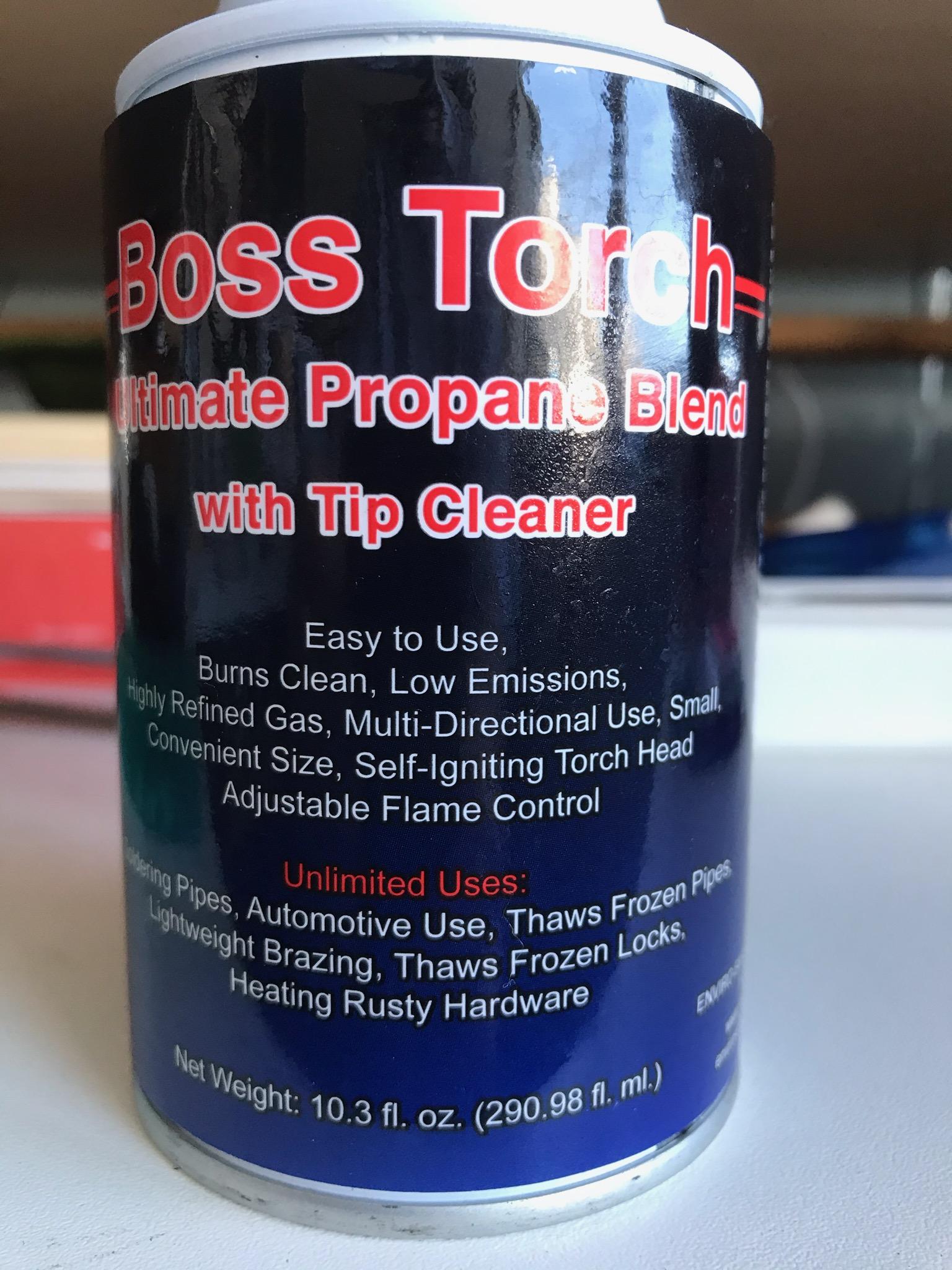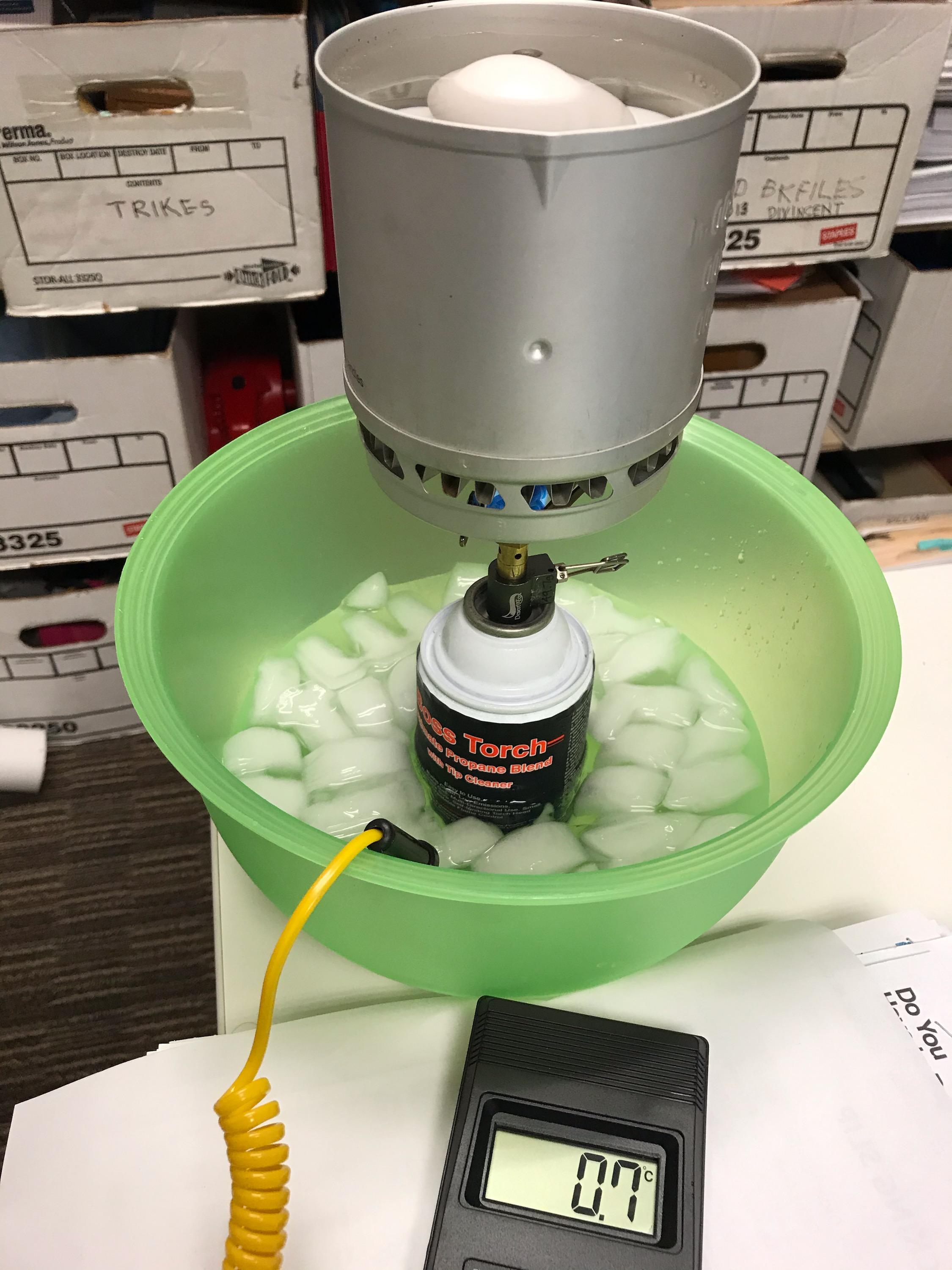Topic
UL Propane stove with 300 BAR refillable 0.6L composite fuel bottle?
Forum Posting
A Membership is required to post in the forums. Login or become a member to post in the member forums!
Home › Forums › Gear Forums › Make Your Own Gear › UL Propane stove with 300 BAR refillable 0.6L composite fuel bottle?
- This topic has 192 replies, 19 voices, and was last updated 3 years, 4 months ago by
 Roger Caffin.
Roger Caffin.
-
AuthorPosts
-
Sep 18, 2020 at 4:19 pm #3676709
Anyone know what the DOT standard is?
Zero failures at 50 C.
I think they are allowing for hot transport trucks.Wry comment: the Dept of Transport regs are primarily concerned about the safety of the transport vehicles, NOT the safety of the users!
Cheers
Sep 18, 2020 at 4:23 pm #3676713Thanks Roger.
50* C = 122* F
Sep 22, 2020 at 12:04 am #3677003Wheee! Case of Torch arrived today.

I need to pop this baby in the freezer overnight and boil some ice water in the morning.
Sep 22, 2020 at 7:49 am #3677027are they 8 ounces each?
how many?
how much?
Sep 22, 2020 at 3:31 pm #3677101The cans say 10.3 fluid ounces net. The weight of an unused can is about 6.8 oz.

12 cans, $47.38 delivered (= $3.95/can), directly from Enviro-Safe.
Sep 22, 2020 at 5:06 pm #3677111Boss Torch Gas Refill Case of 12 Cans #5435
$29.95 PLUS SHIPPING
Sep 22, 2020 at 5:26 pm #3677113Yeah, the GD shipping was $18!!!
Sep 23, 2020 at 10:21 am #3677171 Sep 23, 2020 at 11:00 am #3677173
Sep 23, 2020 at 11:00 am #3677173good test, that ought to simulate operation at 33 F
but, cheap butane would work at that temperature. That’s not a very cold temperature
for me, camping at 20 F is pretty cold. I don’t have much desire to go colder than that. Maybe 10 F to get a little safety margin
putting in freezer that’s 0 F, and then seeing if there’s still pressure when you release the stove valve. If there’s any pressure at all, it should operate good at 10 F – due to evaporative cooling, at 10 F air temp, the canister will cool 10 F for an upright stove.
another thing is with a water bath like that, if the water is 33 F, and the canister wants to cool below that due to evaporative cooling, the water bath will transfer heat to the canister as fast as it evaporative cools, so it will keep the canister close to 33 F. Your test shows that it should operate good at 43 F air temp.
In my opinion : )
Good that you’re testing it though
Sep 23, 2020 at 11:13 am #3677175Great. David, you now we have to start testing using dry ice!
Sep 23, 2020 at 11:14 am #3677177The lowest I can get with water ice is 0* C. Dry ice is too cold at -78.5* C. So how can I get closer to the -43.6* C boiling temperature of propane? Maybe chunks of dry ice stirred into brine?
Sep 23, 2020 at 12:52 pm #3677182Antifreeze chilled with dry ice:
https://www.sparkplugs.com/learning-center/article/653/quest-for-the-ideal-coolant-ratio
Looks like you want ~45/55 mixture
Sep 23, 2020 at 1:18 pm #3677186@bzhayes: That’s awesome! Thanks. Assuming it’s a straight-line ratio between mixture percentage and degree of temperature change I think it would be about 47/53 to get to -44* F, in which case I would shoot for 48/52 to get some propane vapor pressure.
Sep 23, 2020 at 1:45 pm #3677192A realistic test is to put it in air at a particular temperature and boil a pint of water. Evaporative cooling will cool down the canister maybe 7 F during the boil. If the canister is mostly empty – the worst case. Plus, the canister needs to be another 3 F warmer than the boiling temperature to provide enough pressure to operate the stove. So, the air temperature needs to be about 10 F warmer than the boiling temperature for the stove to operate.
putting it into a liquid bath at a particular temperature is a different test. Heat from the liquid bath will keep the canister at that temperature, the canister will not lose that 7 F due to evaporative cooling. You could just account for this by adding 7 F to the liquid bath temperature – that would be the air temperature that it could work at.
but, an easier test is to put the stove onto the canister. Leave it in freezer which should be 0 F. After it stabilizes for a few hours (over night?) pull the canister out of the freezer and quickly open up the stove valve. If there is any pressure, then the stove should be able to boil a pint of water at an air temperature 10 F warmer than that. 3 F to provide enough pressure for the stove to operate, and another 7 F to account for evaporative cooling.
Sep 23, 2020 at 1:51 pm #3677194you could turn the temperature of your freezer up or down to dial in exactly what temperature you barely have any pressure
Sep 23, 2020 at 2:15 pm #3677195The other thing you could test for is whether you have pure isobutane or some propane
With a full canister, you could have isobutane, like MSR Isopro. It has a boiling temperature of 11 F, so you can operate it at a 21 F air temperature.
Pure Isobutane is expensive. To refine it it requires multiple stages of fractionation.
It’s cheaper to have a mixture of isobutane and n butane, about 50% each. That has a boiling temperature of about 21 F, so it can operate at an air temperature of about 31 F.
But, you can make it work at an air temperature of 21 F by just adding a little propane. Propane is cheaper than isobutane because it’s boiling temperature is so much lower. One pass through a fractionator.
But, in an upright stove, as you use up the fuel, propane will evaporate preferentially. When you’re more than half way through the canister, almost all the propane will be gone. You’ll just be left with cheap butane, so the boiling temp will be about 21 F so you can only operate at 31 F.
To test for this, first, find the boiling temp of a full canister by putting in the freezer. Then operate the stove normally using up most of the fuel and then find the boiling temperature again. If you started with pure isobutane, the boiling temperature will be unchanged. If you started with cheap butane and propane, the boiling temperature will be increased.
Sep 23, 2020 at 2:20 pm #3677196Rather than putting in freezer, you could use the liquid bath, but don’t bother actually operating it, just open up the valve and see if there’s any pressure. If you could change the liquid bath temperature, you could do so until you just barely got any pressure, that would be close enough to the boiling temperature.
Add 10 F to get the air temperature the stove will operate at
Sep 23, 2020 at 2:45 pm #3677198Roger that. Thanks Jerry. So the mixture in the chart linked about would be 50/50 to get down to 34 F, which is 10 F above the boiling point of propane, and see if there’s pressure.
Sep 23, 2020 at 3:06 pm #3677200yeah, and use your temperature probe to measure what the temperature actually is
Sep 30, 2020 at 9:07 am #3677940David, does that make a 16.11 oz total weight for 1 full can?
(The cans say 10.3 fluid ounces net. The weight of an unused can is about 6.8 oz.)
Sep 30, 2020 at 3:41 pm #367796310.3+6.8 = 17.1 ??
CheersSep 30, 2020 at 6:19 pm #3677987The lowest I can get with water ice is 0* C. Dry ice is too cold at -78.5* C. So how can I get closer to the -43.6* C boiling temperature of propane? Maybe chunks of dry ice stirred into brine?
What is the latest on your dry ice experiments?
Sep 30, 2020 at 6:58 pm #3677992The lowest I can get with water ice is 0* C
Technically speaking, that is not true. 0 C may be the triple point for water/ice, but ice can be a lot colder.A modern freezer should be holding about -18 C (0 F) most of the time. Put a canister in the freezer in a decent-sized tub of water and let it freeze solid. Um – a smart person will put a thin layer of foam (1.5 mm?) around the canister first, to handle any expansion/contraction. When you take the canister out of the freezer, immediately wrap the block of ice up in a good layer of insulation (foam + reflector) and stick a temperature probe in there as well.
OK, the block of ice will start to warm up – but only slowly if your insulation is good. Now try running the stove/canister while monitoring the temperature.
Cheers
Sep 30, 2020 at 7:24 pm #3677994Antifreeze and/or dry ice??
Just create a brine / water-ice bath. With NaCl for modest freezing-point depression and multiple salts even lower (sidewalk-melting salt mixes being cheap and designed for low-temps). You can also make modestly concentrated brine ice cubes in ice cubes trays so the melting of pure water ice cubes isn’t diluting your brine so much.
All of this is easier with a dedicated chest freezer set to a low temperature for the halibut, salmon and caribou in it. The problem with most fridge/freezer combos, if that’s your only freezer, is if you set the freezer on its coldest, you can’t serve the ice cream – it’s too hard.
Or just drive to Fairbanks in winter for some -30F/-34C weather.
Safety tip: dedicate one canister to testing in brine and mark it clearly. I’d worry about its long-term use because of possible rusting, although you could minimize that by rinsing it thoroughly and drying it after any tests.
Sep 30, 2020 at 7:27 pm #3677996@geneh_bpl: There may be some confusion because of the English system units vs. Metric. A new, full can weighs 192 grams (6.8 oz) for everything – can and contents. The 10.3 fluid ounces net content weighs a lot less than 192 gm/6.8 oz. Don’t know the weight of the can itself yet so I can subtract to calculate weight of contents, as I have not used one up yet.
@zelph2: Haven’t had a chance to do any super cold testing yet, but when I do it will be a antifreeze + water solution cooled with dry ice to -34 F. -
AuthorPosts
- You must be logged in to reply to this topic.
Forum Posting
A Membership is required to post in the forums. Login or become a member to post in the member forums!
Our Community Posts are Moderated
Backpacking Light community posts are moderated and here to foster helpful and positive discussions about lightweight backpacking. Please be mindful of our values and boundaries and review our Community Guidelines prior to posting.
Get the Newsletter
Gear Research & Discovery Tools
- Browse our curated Gear Shop
- See the latest Gear Deals and Sales
- Our Recommendations
- Search for Gear on Sale with the Gear Finder
- Used Gear Swap
- Member Gear Reviews and BPL Gear Review Articles
- Browse by Gear Type or Brand.





